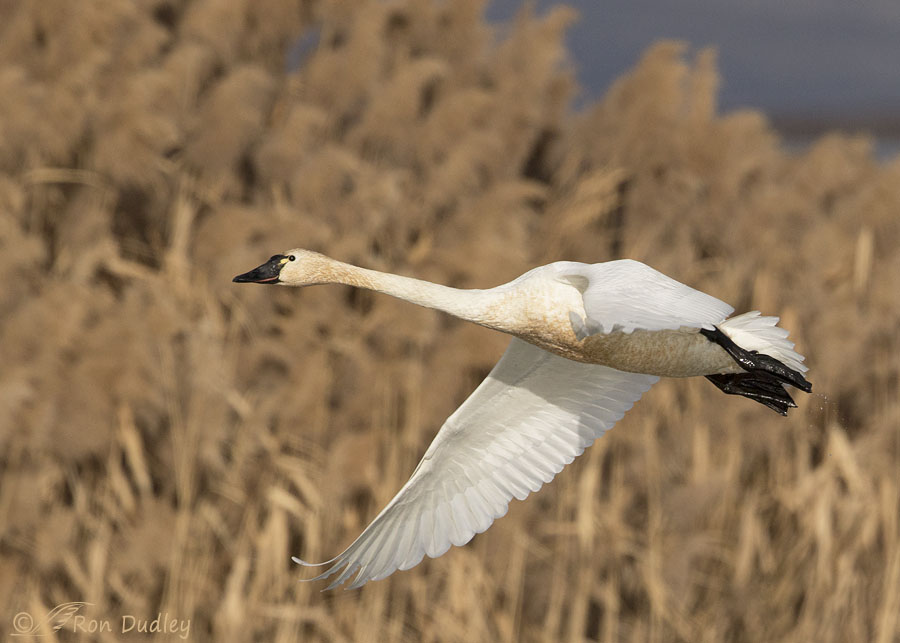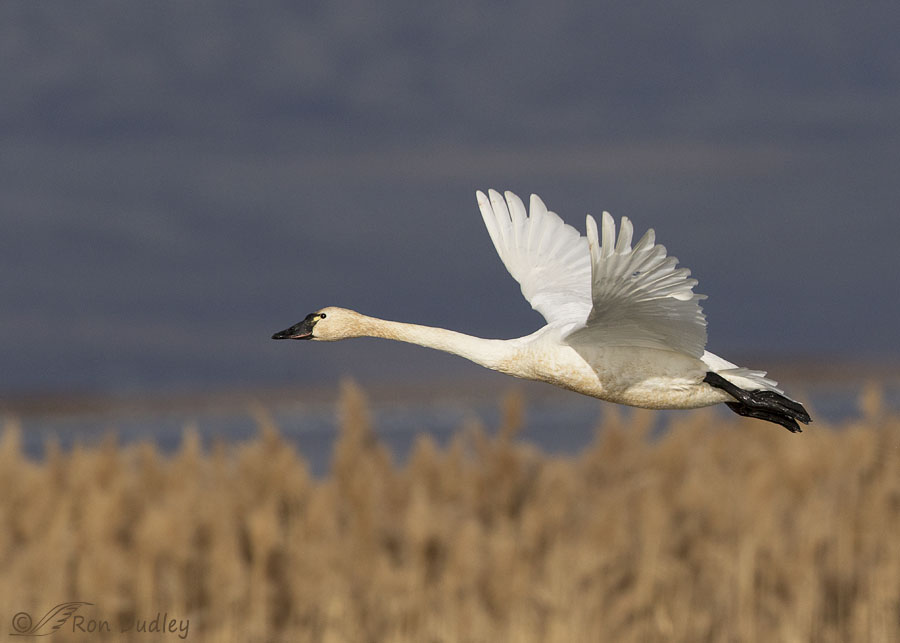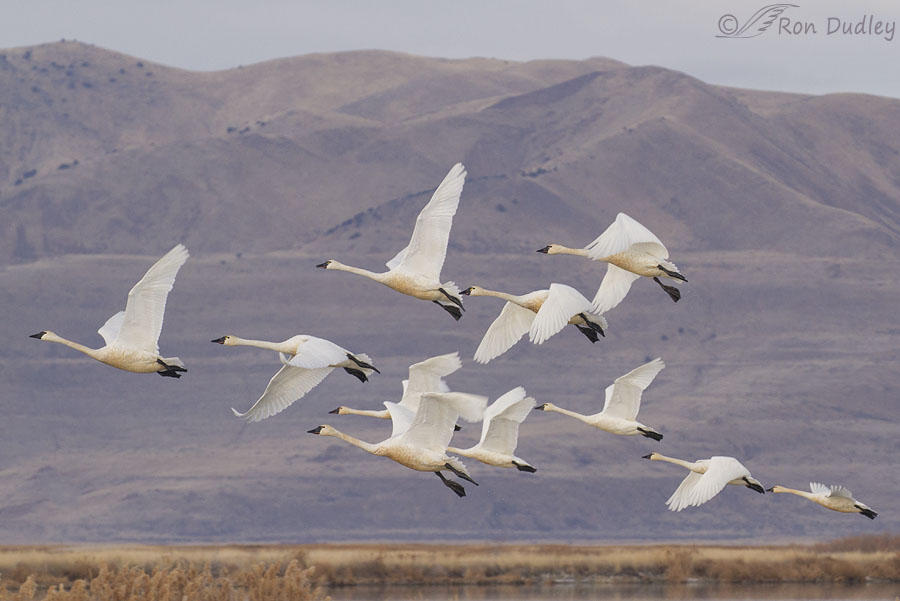Some folks don’t get very excited about Tundra Swans. I do, they’re damned impressive and elegant creatures. They’re large and graceful, their calls are haunting as they reverberate over the wetlands and their big, noisy flocks often mark the changing season for me.
In March of 1806 Meriwether Lewis called this species the Whistling Swan and the name stuck for many years. In some circles it’s still the name of choice.
I photographed this one ten months ago at Bear River MBR.

1/2500, f/9, ISO 500, Canon 7D Mark II, Canon EF 500mm f/4L IS II USM + EF 1.4 III Extender, not baited, set up or called in
When these two shots were taken the swan had direct sunlight on it but the phrags in the middle background were in semi-shade and the mountains in the far background (upper right in this photo) were in deep shade, producing something of a spotlight effect on the bird. I also like the good detail and the light in its eye. For several reasons it’s often difficult to get an easily seen catch light in this species.

1/3200, f/9, ISO 500, Canon 7D Mark II, Canon EF 500mm f/4L IS II USM + EF 1.4 III Extender, not baited, set up or called in
Two frames later the spotlight effect was enhanced when the backdrop of the swan became the deeply shaded mountains and there was still direct sunlight on the bird. As you can imagine an exposure like this with a white bird against a very dark background is tricky but I like the way it turned out.
My original intention was to post these two photos today and leave it at that but then I realized they gave me an excuse to post another one that I otherwise wouldn’t have.
1/640, f/9, ISO 800, Canon 7D Mark II, Canon EF 500mm f/4L IS II USM @ 271mm, not baited, set up or called in
This shot was taken on the same morning and from the same vantage point so you can see the Promontory Mountains that were deeply shaded in the previous photos and there’s a sliver of the refuge ponds and wetlands at bottom. I wish we could see a little more of them down there but it wasn’t to be because I lost some of it when I had to rotate the image to make it level.
So why was I reluctant to post this photo? Because I cheated and cloned out portions of two swans at the frame edges. I’m not sure what I dislike more – cutting birds in half or cloning. I guess it’s a tossup.
In my experience there are two huge difficulties with photographing groups of birds in relatively tight flocks – cutting off portions of birds at the frame edges and having birds partially or mostly hidden by other birds.
At least this time the latter problem was relatively minor.
Ron
Geology note:
In the last photo we can see at least 3 horizontal “benches” left behind by shoreline erosion of old Lake Bonneville. The highest and most prominent bench (at about wingtip level of the leading swan) is called the Bonneville Bench and marks the deepest level of the lake. At that time the lake was huge, covering much of Utah and parts of Idaho and Nevada. It covered over 20,000 square miles and was about 980 feet deep.
Then 14,500 years ago the lake level fell catastrophically when it overflowed at Red Rock Pass, Idaho and washed away a natural dam. The level of the huge lake fell 344 feet in about a year to its next lowest level, the Provo Level, that we see bisecting the body of the leading swan. The flood was catastrophic and there’s still geological evidence of it in the Snake and Columbia River drainages. Scientists estimate in just the first few weeks it released 1000 cubic miles of water into the Snake River drainage..
Utah’s geological history is nothing short of spectacular.



Oh My! Most impressive Mr. Dudley!
Charlotte
Spectacular third shot! We visit Yellowstone often, but never see this number of swans anymore. Cloning to get rid of bird parts doesn’t bother me at all.
Thank you, Buff.
What gorgeous birds and photos. And a geology lesson to boot? You are too good to us, Professor. 😀
My readers deserve it, Arwen… 🙂
I actually said, “Wow!” out loud when I got to your last shot. What a gorgeous sight!
Wow again after reading Dick’s and your comments about continental drift/seafloor spreading. I can’t imagine how “Earth-shaking” (pun intended) that must have been. It’s one of those paradigms that has always been part of my lifetime. I guess I can compare this discovery to that of planets around stars other than our sun; the first confirmation occurring during my first year teaching high school. Our science department went out to celebrate! (Yes, we were an odd bunch.)
Now I’m going down the rabbit hole of imagining the impact of similar life-changing scientific discoveries…brain candy is fun! 😀
“brain candy is fun”
Isn’t it, Marty! When I’m sitting and waiting for birds to show up or cooperate I often think of stuff like that. Helps to pass the time in a pleasant way. Thank you.
Three beautiful images…notice that heads seems to be darker than their bodies…are theyvstained from diving? Thought they actually dove for and ate the nourishing rich mud when other foods were scarce and unavailable….
Patty, they don’t dive. They just reach with their long necks to get at and eat vegetation from the bottom. Since their bellies and heads spend a lot of time submerged they’re more heavily stained.
Last year was spectacular for photographing the swans. I was hoping for the chance again this year but so far they are not by the auto loop.
It sure was.
Yes, bird photography ain’t easy, but you’re sure good at it. Love the swans. I’ve been told the yellow on them is from iron in water they’ve been in. Is that true? I’m okay with your cloning, and appreciate your mentioning it to us. It would have been easy not to–but your ethics are as outstanding as your photos!
Yes, it’s iron staining, Nancy. Thanks very much for the kind words.
Love all three images.
It is the geology footnote which blows me away today though.
Wowsers. That must have been an event to see (from a safe distance). And undoubtedly caused huge changes to ecology for considerable distances.
I’d love to have seen it, EC. My imagination runs wild just thinking about it.
The bonus image is lovely. I don’t see the Swans in my area, but sure they are around once in a while.I have seen some white birds floating around the Tongue River reservoir and that could be them. Thanks for the pictures again, you want each picture to be perfect, but it sure does not bother me, I just like to see the birds or animals. Nature Lover that I am. 🙂
Thank you, Trudy.
“Utah’s geological history is nothing short of spectacular.”
What a geologic lesson. Humans/Native Americans at that time certainly had a show if they were living on the shore of the lake.
Love the images by the way, but since my second major was geology I particularly enjoy learning about the geology of parts of the country I probably will never see.
Many Thanks.
Dick, I got my first serious taste of geology in college in the late 60’s, soon after continental drift and sea floor spreading became accepted as fact. I could hardly believe what the prof was telling us!
I am right with you – 1959 1965 were interesting years for science. I loved Continental drift. Until then no one thought planets drifted on molten magma/rock.. It was such a neat fact. Almost as important as Darwin’s Theory of Evolution. One fact always keep the mind open to new ideas.
Very Nice shot Ron. Just returned from Bosque two days before Thanksgiving, and the Snow Geese are there in uncountable numbers this year. Getting nice shots in flight like this can be a challenge, and those “half-birds” can be disappointing. Thanks for sharing!
Those Snow Geese sound like fun. Thanks, Jim.
I especially love that last shot—-in trying to analyze why it feels so “comfortable”, I see that the angles of many of the swans’ wings mirror the slopes of the mountain flanks
behind them–a beautiful linear rhythm ….I grew up in Salt Lake, looked at the benches daily, and never knew that it was a catastrophic event that emptied Lake Bonneville–
I learn something DAILY from your blog–thanks !
Kris, I’d love to have stood there at Red Rock Pass and watched the event unfold. From a safe distance of course…
Love Tundra Swans Ron. We have three of them at one of our lakes right now. We have pretty much the same problem you do. Some sun, but in the mornings mostly bleak. Love the group photo, and will go with cloning over cut in half birds anytime. And if the photographer does not tell the viewer – who knows? Have a great day.
Everett Sanborn, Prescott AZ
Today I had sun but no birds, Everett. Sad and maddening.
Hi Ron, Yes, group photos are tough. It seems nearly impossible to get a shot where everyone is separated and you don’t have someone either decapitated or footless. My fav today would be the second image. Like the majority of the bird against a nice layered background. Thanks for the geology lesson. When we have gone from S. Cal to Montana we typically go across NE Nevada from Ely to Wendover and there are some great examples of ancient shore-lines along that route. Fun stuff and thank for sharing.
Yes, I can tell you’ve been there and done that, Frank. Frustrating isn’t it!
I often get mentally “lost” when I’m looking at those old shorelines – wondering what animals wandered along them so long ago.
Gorgeous birds, Ron. 🙂 Don’t know that I’ve ever seen/heard them – see we’re on the edge of their migration route. The last shot, even if cleaned up a bit, is beautiful and thx for the geology lesson on Utah! 🙂
Thanks on both counts, Judy. There are swans of both species in the Centennial Valley – a relatively short trip for you… Hint, hint 🙂
“some day” hopefully! 🙂
Ron, seeing as I’m from the Southeast where neither of the two native North American swans naturally occur, I simply can’t understand how people don’t get excited for these swans! And believe me, I do know the horrors of creating an otherwise great photo and clipping a body part (I had taken some photos of a Killdeer but it caught me off guard by stretching and taking off without warning and boy I screwed that shot up!). Great photos, and I sure hope you can find some more cooperative birds this season!
Thanks, Xavier. Cooperative birds are hard to come by this year and the forecast indicates that the weather isn’t going to cooperate for a while either (sunshine today but after that it looks bleak). Bird photography ain’t easy… 🙂